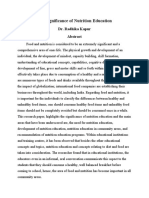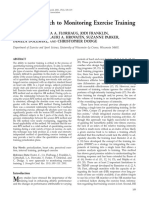Activity # 5 - Santos, Aira Kristelle M
Activity # 5 - Santos, Aira Kristelle M
Uploaded by
Ai MendozaCopyright:
Available Formats
Activity # 5 - Santos, Aira Kristelle M
Activity # 5 - Santos, Aira Kristelle M
Uploaded by
Ai MendozaOriginal Title
Copyright
Available Formats
Share this document
Did you find this document useful?
Is this content inappropriate?
Copyright:
Available Formats
Activity # 5 - Santos, Aira Kristelle M
Activity # 5 - Santos, Aira Kristelle M
Uploaded by
Ai MendozaCopyright:
Available Formats
Recognition for Proficiency in Quality Asia’s FIRST IiP – Gold
Management in 2015 Accredited University Granted INSTITUTIONAL ACCREDITATION Status
I. Evidence-Based Article
Nutrition Food Policy Guidelines
Throughout history, public health nutrition has served to shape nutrition food
policy, beginning primarily as a population-level approach to disease prevention, health
promotion, and addressing malnutrition and undernutrition. For example, in the early
1800s, public health policies formed public school lunch programs, milk stations, and
state and local health departments. Primarily in the United States, the focus began with
addressing infant and child morbidity and mortality, and diseases caused by nutritional
deficiencies such as rickets and scurvy. As industrialization increased, nutrition food
policy has shifted toward disease prevention from dietary excesses with the increased
availability of nutrient-poor foods and the resultant obesity epidemic, which has been
implicated in diet-related noncommunicable diseases such as diabetes, atherosclerotic
cardiovascular disease, hypertension, and certain types of cancers.
Nutrition food policy is a global concern, often addressing food shortages with war
and famine in less developed nations and shifting as noted elsewhere in this article, to
focus on chronic diseases caused by decreased physical activity and poor dietary intake
in developing countries and countries in transition as they become more industrialized
and urban. International organizations such as the World Health Organization, World
Public Health Nutrition Association, and the Food First Information and Action Network
International, review nutrition food policy from a public health perspective taking into
account the global food economy. Most recently, in December of 2020, the World Health
Organization pronounced 2021 to 2030 to be the Decade of Healthy Aging, adding the
health concerns of a rapidly aging population to their focus in public health research.
Throughout the guidelines and in each individual phase of the lifespan the phrases
“nutrient-dense” and “dietary pattern” are used in a specific fashion to promote maximum
benefit in food and beverages consumed. The scientific panel has defined nutrient-dense
foods as those foods that provide high-quality vitamins, minerals, and other healthful
components while containing little added sugar, saturated fat, and sodium. “Dietary
pattern” is representative of consistency in consuming nutrient-dense foods in proper
amounts from all food groups. Recommendations are subsequently delivered based on
lifespan appropriate, nutrient-dense food choices.
Recognition for Proficiency in Quality Asia’s FIRST IiP – Gold
Management in 2015 Accredited University Granted INSTITUTIONAL ACCREDITATION Status
II. Reflective Essay
1. Briefly describe the scenario.
In the above-given article from ScienceDirect, it was highlighted how a healthy diet
aids an individual to be protected against malnutrition in all its forms, as well as non-
communicable diseases (NCDs), including diabetes, heart disease, stroke, and cancer.
However, in this modern era, increased production of processed foods, urbanization, and
altering lifestyle have led to a shift in dietary patterns. Indeed, now, instead of consuming
fruits and vegetables, individuals tend to eat more foods that are high in energy, fats, and
salt. In fact, the precise make-up of a diversified, balanced, and healthy diet varies
depending on an individual's characteristics, including age, gender, lifestyle, and degree
of physical activity. Moreover, cultural context, locally available foods, and dietary
customs are also factors. With that, proper nutritional guidelines must be directed and
considered to change the lifestyle that one is being used to. In the first two years of a
child’s life, optimal nutrition fosters healthy growth and improves cognitive development.
It is said to reduce the risk of becoming overweight and developing non-communicable
diseases later in life. Here, nurses must provide advice on a healthy diet for infants and
children. It was discussed that should be breastfed exclusively during the first six months
of life. Moreover, they should be continuously breastfed until two years of age and
beyond. Truly, from six months of age, breast milk should be complemented with a variety
of adequate, safe, and nutrient-dense foods. Salt and sugars should not be added to
complementary foods. With nutritional guidelines for adults, WHO have expressed that
adult need to have at least 400 grams or five portions of fruit and vegetables per day,
excluding potatoes, sweet potatoes, cassava, and other starchy roots. Additionally, adults
must consume fruits, vegetables, legumes, nuts, and whole grains.
2. How do you feel about it? (You may include comments)
Upon reading and understanding the evidence-based article, I have immensely
appreciated the value of nutrition in our lives. More than the name itself, this shields us
from various leading global health diseases. In point of fact, it strengthens one's immune
system and supports weight management. Moreover, with the article, I have perceived
the role of the government in combating malnutrition and unhealthy lifestyle. Undeniably,
they have a significant role in creating a healthy food environment that enables individuals
Recognition for Proficiency in Quality Asia’s FIRST IiP – Gold
Management in 2015 Accredited University Granted INSTITUTIONAL ACCREDITATION Status
to adopt and maintain healthy dietary practices. With that, I realize how they should
consider practical actions and policies that would put people to such great advantage.
They can even create coherence in national policies and investment plans, encourage
consumer demand for healthy foods and meals, and promote appropriate infant and
young child feeding practices. In the same way, I felt gratified with how the World Health
Organization responded and dealt with issues regarding diet in every corner of the world.
Of course, as an individual, the article made me feel the need to change my habits and
lifestyle. Certainly, proper nutritional guidelines must be upheld. I should also prioritize
what is the most valuable to me, and that is health. After all, prevention is better than
cure, and health is the real wealth.
3. What have you learned from it?
The evidence-based article has taught me various learnings that I can apply in my
everyday living. Undoubtedly, diet evolves over time and is influenced by various social
and economic factors that interact in a complex manner to shape individual dietary
patterns. These factors are income, food prices, personal preferences, beliefs, cultural
traditions, geographical, and environmental aspects. Promoting a healthy environment is
necessary to attain good health and well-being. Generally, change should always start
within ourselves. As eating at least 400 grams of fruit and vegetables per day helps to
ensure an adequate daily intake of dietary fiber, I have learned that we should always
include vegetables and fruits in our meals as well as eat a variety of those. Besides, we
should eat fresh fruit and raw vegetables as snacks. Moreover, to prevent unhealthy
weight gain, it is best to reduce the amount of total fat intake to less than 30% of the total
energy. In this view, we can eat reduced-fat dairy foods and lean meats. Then, we should
limit our consumption of baked, fried, and pre-packaged snacks as these contain
industrially produced trans-fats. As also known, high sodium intake and insufficient
potassium intake contribute to high blood pressure, increasing the risk of heart disease
and stroke. Given that fact, we should reduce our salt intake to the recommended level
of fewer than five grams per day. Salt intake can be reduced by limiting the amount of salt
and high-sodium condiments when cooking and preparing foods. Other than that, we can
limit the consumption of salty snacks and choose products with lower sodium content.
Knowing that consuming free sugars increases the risk of dental caries or tooth decay
and excess calories from foods and drinks high in free sugars also contribute to unhealthy
weight gain, I have come to acquire that we should limit our intake and eat healthy snacks
instead of sugary snacks. With all of these being said, optimum nutrition is the medicine
of tomorrow.
Recognition for Proficiency in Quality Asia’s FIRST IiP – Gold
Management in 2015 Accredited University Granted INSTITUTIONAL ACCREDITATION Status
III. Reference
Wright, M. (2021, September 11). Nutrition Food Policy Guidelines. Retrieved from:
https://www.sciencedirect.com/science/article/pii/S2405799121000815.
Recognition for Proficiency in Quality Asia’s FIRST IiP – Gold
Management in 2015 Accredited University Granted INSTITUTIONAL ACCREDITATION Status
You might also like
- Test Bank For The Science of Nutrition 4th Edition by Thompson PDFDocument10 pagesTest Bank For The Science of Nutrition 4th Edition by Thompson PDFa80891008767% (3)
- On Balanced DietDocument55 pagesOn Balanced Dietshitalsawant100% (5)
- Food and Nutrition - Don RossDocument49 pagesFood and Nutrition - Don RossEivor LynNo ratings yet
- Community NutritionDocument13 pagesCommunity NutritionVaishali Jainarain100% (4)
- 43rd Nutrition Month July 2017Document6 pages43rd Nutrition Month July 2017Ley Domingo Villafuerte GonzalesNo ratings yet
- A Feasibility Study On The Establishment of Kawayan SpaghettiDocument55 pagesA Feasibility Study On The Establishment of Kawayan SpaghettiSueh50% (2)
- DessieDocument10 pagesDessieLemma BerisoNo ratings yet
- Nutrition and Dietetics ProjectDocument6 pagesNutrition and Dietetics ProjectcharlesNo ratings yet
- What Is NutritaionDocument24 pagesWhat Is NutritaionMrs RehanNo ratings yet
- Marshall2019 RewDocument11 pagesMarshall2019 RewAndreea DamianNo ratings yet
- Food and Nutrition Issues and Challanges of CommonDocument24 pagesFood and Nutrition Issues and Challanges of CommonGourav AggarwalNo ratings yet
- Nutritional Needs/ B.Sc. Nursing/ Fundamental of Nursing/ Nutrition/ Sameeksha PatialDocument138 pagesNutritional Needs/ B.Sc. Nursing/ Fundamental of Nursing/ Nutrition/ Sameeksha PatialSameeksha100% (1)
- Unit 1Document73 pagesUnit 1Muskaan DeepNo ratings yet
- Dietary Guidelines For Americans 2020-2025-2Document10 pagesDietary Guidelines For Americans 2020-2025-2Guillermo ValdèsNo ratings yet
- The Link Between Food, Nutrition, Diet and Non-Communicable DiseasesDocument4 pagesThe Link Between Food, Nutrition, Diet and Non-Communicable DiseasesthousanddaysNo ratings yet
- New AssignmentDocument3 pagesNew AssignmentDrew JoanNo ratings yet
- wp2 RevisedDocument8 pageswp2 Revisedapi-491264807No ratings yet
- Food and Mankind GED 303 Spring Semester 2014-2015: SectionDocument6 pagesFood and Mankind GED 303 Spring Semester 2014-2015: SectionSameh SalahNo ratings yet
- Genetically ModifiedDocument2 pagesGenetically ModifiedChong Rui EnNo ratings yet
- Healthier Canteen ProjectDocument4 pagesHealthier Canteen Projectapi-356045953No ratings yet
- The Benefits of A Healthy DietDocument10 pagesThe Benefits of A Healthy Dietcaroltutor50No ratings yet
- Unit 5 Healthy Eating Habits - CompressDocument11 pagesUnit 5 Healthy Eating Habits - CompressMheryl Grace VillegasNo ratings yet
- Independent Study 2Document16 pagesIndependent Study 2samantaNo ratings yet
- In The Learning JournalDocument3 pagesIn The Learning JournalRuva Oscass JimmyNo ratings yet
- DietDocument3 pagesDietMD YUNOS BIN SAHLAN MoeNo ratings yet
- Fast Food Consumption and It's Effect On Health 2Document3 pagesFast Food Consumption and It's Effect On Health 2rayu1905No ratings yet
- Concept of Community NutritionDocument4 pagesConcept of Community NutritionNrs Sani Sule MashiNo ratings yet
- CUHT 118 Group 2 AssignmentDocument6 pagesCUHT 118 Group 2 AssignmentPrecious Tinashe NyakabauNo ratings yet
- Dr. Marzia Zaman SultanaDocument34 pagesDr. Marzia Zaman SultanaAshiquzzaman ChowdhuryNo ratings yet
- Importance of Nutrition Education in Catering and Fast Food BusinessDocument34 pagesImportance of Nutrition Education in Catering and Fast Food BusinessSolomonNo ratings yet
- Dec Research ChaptersDocument85 pagesDec Research ChaptersLa Yanna100% (2)
- HLGuide22 23Document38 pagesHLGuide22 23Luis Gerardo Aguilar CruzNo ratings yet
- PDGNDocument6 pagesPDGNNauman ShahzadNo ratings yet
- The Healthy School Meals Act of 2010: (Rep. Jared Polis, CO)Document3 pagesThe Healthy School Meals Act of 2010: (Rep. Jared Polis, CO)Gabriel MateusNo ratings yet
- Thesis RobinDocument153 pagesThesis RobinPriyaNo ratings yet
- RRLDocument6 pagesRRLPatricia Mae D. RamboangaNo ratings yet
- Ex For Speech About The ObesityDocument3 pagesEx For Speech About The ObesityJenniferjenniferlalalaNo ratings yet
- HealthDocument10 pagesHealthsebaci7622No ratings yet
- Fast Food and Their Impact On HealthDocument8 pagesFast Food and Their Impact On HealthALI SHER HaidriNo ratings yet
- The Significance of Nutrition Education: Dr. Radhika KapurDocument12 pagesThe Significance of Nutrition Education: Dr. Radhika KapurTitis Retno Sawitri SawitriNo ratings yet
- CarbohydratesDocument3 pagesCarbohydratesRheaNo ratings yet
- Community Nutrition Nestle Nutrition InstituteDocument4 pagesCommunity Nutrition Nestle Nutrition InstituteOsamaNo ratings yet
- Annotated Bibliography 4Document4 pagesAnnotated Bibliography 4api-707740998No ratings yet
- E. Nutrition in The ElderlyDocument4 pagesE. Nutrition in The ElderlyjezzgermoNo ratings yet
- Food and Nutrition Thesis TopicsDocument8 pagesFood and Nutrition Thesis TopicsStacy Vasquez100% (2)
- Piis2212267212019934 PDFDocument11 pagesPiis2212267212019934 PDFemeraldwxyzNo ratings yet
- Holmes and Murphy 2016 Nursing in Practice 92Document6 pagesHolmes and Murphy 2016 Nursing in Practice 92Caylynn WoWNo ratings yet
- Chapter 12Document64 pagesChapter 12krisjulywu2No ratings yet
- The Important of Healthy Eating HealthDocument4 pagesThe Important of Healthy Eating Healthandreeagabriela28No ratings yet
- Unit 4 AssignmentDocument13 pagesUnit 4 Assignmentapi-661551711100% (1)
- Food and N Study GuideDocument24 pagesFood and N Study Guidelonique maximeNo ratings yet
- Food FortificationDocument4 pagesFood FortificationmahmudbebejiNo ratings yet
- Healthy Eating Essay ThesisDocument6 pagesHealthy Eating Essay Thesisaflnoexvofebaf100% (2)
- Food Nutrition and Health Study GuideDocument14 pagesFood Nutrition and Health Study Guidelonique maxime50% (2)
- Description of The BusinessDocument113 pagesDescription of The BusinessAngelica Beleo MadalangNo ratings yet
- Dissertation Topics On Food and NutritionDocument5 pagesDissertation Topics On Food and NutritionPayingSomeoneToWriteAPaperScottsdale100% (1)
- Quiz # 3 - Santos, Aira Kristelle M.Document4 pagesQuiz # 3 - Santos, Aira Kristelle M.Ai MendozaNo ratings yet
- Peer Evaluation - Santos, Aira Kristelle M.Document5 pagesPeer Evaluation - Santos, Aira Kristelle M.Ai MendozaNo ratings yet
- Activity # 6 - Santos, Aira Kristelle MDocument6 pagesActivity # 6 - Santos, Aira Kristelle MAi MendozaNo ratings yet
- Activity # 4 - Santos, Aira Kristelle M.Document3 pagesActivity # 4 - Santos, Aira Kristelle M.Ai MendozaNo ratings yet
- Activity # 7 (Part 1) - Santos, Aira Kristelle MDocument11 pagesActivity # 7 (Part 1) - Santos, Aira Kristelle MAi Mendoza100% (1)
- Activity # 5 - Santos, Aira Kristelle MDocument7 pagesActivity # 5 - Santos, Aira Kristelle MAi MendozaNo ratings yet
- Activity # 2 - Santos, Aira Kristelle M.Document9 pagesActivity # 2 - Santos, Aira Kristelle M.Ai MendozaNo ratings yet
- Quiz # 1 - Santos, Aira Kristelle M.Document4 pagesQuiz # 1 - Santos, Aira Kristelle M.Ai MendozaNo ratings yet
- Activity # 3 - Santos, Aira Kristelle M.Document13 pagesActivity # 3 - Santos, Aira Kristelle M.Ai MendozaNo ratings yet
- Activity # 1 - Santos, Aira Kristelle M.Document8 pagesActivity # 1 - Santos, Aira Kristelle M.Ai MendozaNo ratings yet
- Activity # 2 - Santos, Aira Kristelle M.Document9 pagesActivity # 2 - Santos, Aira Kristelle M.Ai MendozaNo ratings yet
- Activity # 3 - Santos, Aira Kristelle M.Document2 pagesActivity # 3 - Santos, Aira Kristelle M.Ai MendozaNo ratings yet
- Academic Writing (Citation) : Submitted ToDocument5 pagesAcademic Writing (Citation) : Submitted ToAi MendozaNo ratings yet
- Activity # 4 - Santos, Aira Kristelle MDocument13 pagesActivity # 4 - Santos, Aira Kristelle MAi MendozaNo ratings yet
- Basic Skills and MovementsDocument2 pagesBasic Skills and MovementsAi MendozaNo ratings yet
- Activity # 1 - Santos, Aira Kristelle M.Document4 pagesActivity # 1 - Santos, Aira Kristelle M.Ai MendozaNo ratings yet
- Activity # 4 - LacsamanaDocument3 pagesActivity # 4 - LacsamanaAi MendozaNo ratings yet
- Submitted To: Submitted By:: Ma'am Prenses Sara D. Cay PE 2 Professor Aira Kristelle M. Santos BSN 1-1Document5 pagesSubmitted To: Submitted By:: Ma'am Prenses Sara D. Cay PE 2 Professor Aira Kristelle M. Santos BSN 1-1Ai MendozaNo ratings yet
- Santos, Aira Kristelle M. - The Declaration of Indepence of The Filipino PeopleDocument5 pagesSantos, Aira Kristelle M. - The Declaration of Indepence of The Filipino PeopleAi MendozaNo ratings yet
- Activity # 3 & 4 - Santos, Aira Kristelle M.Document12 pagesActivity # 3 & 4 - Santos, Aira Kristelle M.Ai MendozaNo ratings yet
- Santos, Aira Kristelle M. - Customs of The TagalogsDocument5 pagesSantos, Aira Kristelle M. - Customs of The TagalogsAi MendozaNo ratings yet
- KwashiorkorDocument4 pagesKwashiorkorDanti NurdindayantiNo ratings yet
- 6 Essential Nutrients and Their FunctionsDocument2 pages6 Essential Nutrients and Their FunctionsYumi AokiNo ratings yet
- NDT Lec FinalsDocument15 pagesNDT Lec FinalsShainaChescaEvansNo ratings yet
- Aerobic Fitness and Resistance TrainingDocument12 pagesAerobic Fitness and Resistance TrainingJhobert MunchijoNo ratings yet
- Devina Singh 2023 SBA Human and Social BiologyDocument38 pagesDevina Singh 2023 SBA Human and Social BiologyDevina SinghNo ratings yet
- National IMAM Guideline 15 February 2018Document160 pagesNational IMAM Guideline 15 February 2018Satrumin ShirimaNo ratings yet
- Anti-Obesity Focused On External Preparation....Document13 pagesAnti-Obesity Focused On External Preparation....Balaji Kumar PanigrahiNo ratings yet
- Melatonin Gummies: Body Requirement and Effects of MelatoninDocument13 pagesMelatonin Gummies: Body Requirement and Effects of MelatoninmelatoningummiesNo ratings yet
- 1st Quarter Test MAPEH 7Document3 pages1st Quarter Test MAPEH 7Cherilyn SaagundoNo ratings yet
- 1 Diet Guide PDFDocument43 pages1 Diet Guide PDFYG1No ratings yet
- Ielts Mock TestDocument9 pagesIelts Mock Testluis mosqueraNo ratings yet
- Training Distance Runners: by Todd Thorson Ipswich SchoolDocument36 pagesTraining Distance Runners: by Todd Thorson Ipswich SchoolYared TegegneNo ratings yet
- Summative Exam Pe and HealthDocument2 pagesSummative Exam Pe and HealthLezette Escario50% (2)
- Basic Principles in Occupational Hygiene: Evah MainaDocument35 pagesBasic Principles in Occupational Hygiene: Evah MainaMokua FedinardNo ratings yet
- International Labour Organization - Conventions and Recommendations.Document3 pagesInternational Labour Organization - Conventions and Recommendations.عبدالله العتيبيNo ratings yet
- CarbCycle PDFDocument2 pagesCarbCycle PDFRayNo ratings yet
- All About VapingREALDocument8 pagesAll About VapingREALKatherine CroweNo ratings yet
- A New Approach To Monitoring Exercise TrainingDocument7 pagesA New Approach To Monitoring Exercise TrainingDanilo Barreto SouzaNo ratings yet
- QuestionaireDocument3 pagesQuestionairebashirkinza679No ratings yet
- So That in Order To: Test 2 Name: Date: A. Choose or To Complete The SentencesDocument6 pagesSo That in Order To: Test 2 Name: Date: A. Choose or To Complete The SentencesNashfati IkraminaNo ratings yet
- Activity Risk Assessment Template - v3Document8 pagesActivity Risk Assessment Template - v3rob_woodward_1No ratings yet
- Dialog Bahasa InggrisDocument5 pagesDialog Bahasa InggrisAngelicca Sunja100% (1)
- Daftar PustakaDocument6 pagesDaftar PustakaRahma SariNo ratings yet
- RDA Chart RDA TableDocument4 pagesRDA Chart RDA TableVisshan SpirulinaNo ratings yet
- Extreme Muscle BuilderDocument2 pagesExtreme Muscle Builderkbozic1998No ratings yet
- Aerobic ExerciseDocument28 pagesAerobic ExerciseAshie SmithNo ratings yet
- 2023 Nutrion Month Narrative ReportDocument10 pages2023 Nutrion Month Narrative ReportLorelynSonioMoseNo ratings yet
- UntitledDocument548 pagesUntitledthup wrdNo ratings yet
- Stress Management - How To Reduce, Prevent, and Cope With StressDocument4 pagesStress Management - How To Reduce, Prevent, and Cope With StressNaveen Kiran Manomayi Latha100% (1)














































































































